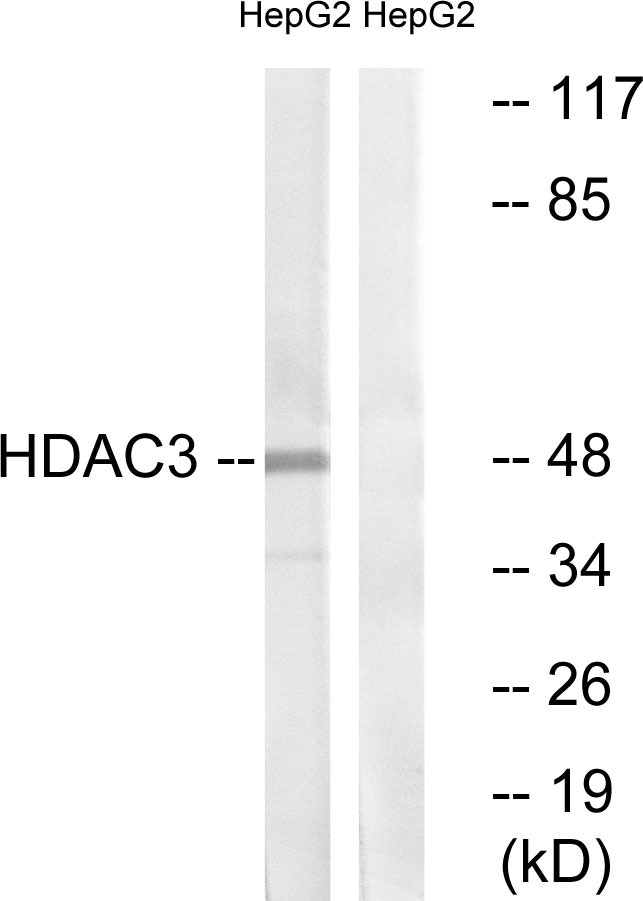HDAC3 antibody [C3], C-term
GTX109679
ApplicationsImmunoFluorescence, ImmunoPrecipitation, Western Blot, ChIP Chromatin ImmunoPrecipitation, ImmunoCytoChemistry, ImmunoHistoChemistry, ImmunoHistoChemistry Paraffin
Product group Antibodies
TargetHDAC3
Overview
- SupplierGeneTex
- Product NameHDAC3 antibody [C3], C-term
- Delivery Days Customer9
- Application Supplier NoteWB: 1:500-1:3000. ICC/IF: 1:100-1:1000. IHC-P: 1:100-1:1000. IP: 1:100-1:500. *Optimal dilutions/concentrations should be determined by the researcher.Not tested in other applications.
- ApplicationsImmunoFluorescence, ImmunoPrecipitation, Western Blot, ChIP Chromatin ImmunoPrecipitation, ImmunoCytoChemistry, ImmunoHistoChemistry, ImmunoHistoChemistry Paraffin
- CertificationResearch Use Only
- ClonalityPolyclonal
- Concentration0.66 mg/ml
- ConjugateUnconjugated
- Gene ID8841
- Target nameHDAC3
- Target descriptionhistone deacetylase 3
- Target synonymsHD3, KDAC3, RPD3, RPD3-2, histone deacetylase 3, SMAP45, protein deacetylase HDAC3, protein deacylase HDAC3
- HostRabbit
- IsotypeIgG
- Protein IDO15379
- Protein NameHistone deacetylase 3
- Scientific DescriptionHistones play a critical role in transcriptional regulation, cell cycle progression, and developmental events. Histone acetylation/deacetylation alters chromosome structure and affects transcription factor access to DNA. The protein encoded by this gene belongs to the histone deacetylase/acuc/apha family. It has histone deacetylase activity and represses transcription when tethered to a promoter. It may participate in the regulation of transcription through its binding with the zinc-finger transcription factor YY1. This protein can also down-regulate p53 function and thus modulate cell growth and apoptosis. This gene is regarded as a potential tumor suppressor gene. [provided by RefSeq]
- Storage Instruction-20°C or -80°C,2°C to 8°C
- UNSPSC12352203
References
- Xu Y, Xiong Y, Liu Y, et al. Activation of goblet cell Piezo1 alleviates mucus barrier damage in mice exposed to WAS by inhibiting H3K9me3 modification. Cell Biosci. 2023,13(1):7. doi: 10.1186/s13578-023-00952-5Read this paper
- Richter HJ, Hauck AK, Batmanov K, et al. Balanced control of thermogenesis by nuclear receptor corepressors in brown adipose tissue. Proc Natl Acad Sci U S A. 2022,119(33):e2205276119. doi: 10.1073/pnas.2205276119Read this paper
- Chen CY, Chen CC, Chuang WY, et al. Hydroxygenkwanin Inhibits Class I HDAC Expression and Synergistically Enhances the Antitumor Activity of Sorafenib in Liver Cancer Cells. Front Oncol. 2020,10:216. doi: 10.3389/fonc.2020.00216Read this paper
- Huang D, Chen J, Yang L, et al. NKILA lncRNA promotes tumor immune evasion by sensitizing T cells to activation-induced cell death. Nat Immunol. 2018,19(10):1112-1125. doi: 10.1038/s41590-018-0207-yRead this paper
- Lee JY, Kuo CW, Tsai SL, et al. Inhibition of HDAC3- and HDAC6-Promoted Survivin Expression Plays an Important Role in SAHA-Induced Autophagy and Viability Reduction in Breast Cancer Cells. Front Pharmacol. 2016,7:81. doi: 10.3389/fphar.2016.00081Read this paper
- Yuan H, Niu Y, Liu X, et al. Exercise increases the binding of MEF2A to the Cpt1b promoter in mouse skeletal muscle. Acta Physiol (Oxf). 2014,212(4):283-92. doi: 10.1111/apha.12395Read this paper
- Chuang C, Pan J, Hawke DH, et al. NudC deacetylation regulates mitotic progression. PLoS One. 2013,8(9):e73841. doi: 10.1371/journal.pone.0073841Read this paper







![WB analysis of various samples using GTX00834 HDAC3 antibody [GT1144]. Dilution : 1:1000 Loading : 25 microg](https://www.genetex.com/upload/website/prouct_img/normal/GTX00834/GTX00834_20200508_WB_w_23053121_289.webp)
![IHC-P analysis of human esophagus cancer (left) and breast carcinoma tissue (right) using GTX83172 HDAC3 antibody [3A7B5].](https://www.genetex.com/upload/website/prouct_img/normal/GTX83172/GTX83172_20170912_IHC-P_w_23061322_791.webp)